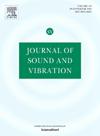Coupling mechanisms of large-deformable beams and nonlinear acoustic waves in unbounded domains of heavy fluids
IF 4.9
2区 工程技术
Q1 ACOUSTICS
引用次数: 0
Abstract
The nonlinear vibration and acoustic radiation of large-deformable beams in light fluids have been studied to some extent, but the coupling effects in heavy fluids remain unclear. This paper aims to reveal the coupling mechanisms of large-deformable beams and nonlinear acoustic waves in heavy unbounded fluid domains. A partitioned strongly coupled nonlinear frequency-domain finite element method is established to solve the nonlinear beam and acoustic equations. The modal and harmonic components of beam displacement, acoustic pressure, excitation input energy, beam damping dissipation energy, and acoustic radiation energy are analyzed for elucidating the coupling mechanisms. The results show that, under the same external harmonic excitation conditions, compared to the frequency responses of beam displacement and acoustic pressure in air, those in water shift to lower frequencies, with larger amplitudes and stronger nonlinear effects. Due to the structural cubic geometric nonlinearity and large-amplitude excitation, super-harmonic resonances are observed in the frequency responses of beam displacement and acoustic pressure. Under super-harmonic resonance and low-order primary resonance conditions, the triple-frequency components of most modes account for a significant proportion of their total responses. Under high-order primary resonance conditions, compared to air, the beam vibration in water is more likely to excite low-order modes in the radiated acoustic field. Relatively high acoustic radiation efficiency can be witnessed in the first primary resonance in air and the high-order primary resonance in water. These results will help to understand the differences and connections in the coupling characteristics of vibration and radiated acoustic fields of large-deformable structures in light and heavy fluids.
重流体无界域中大变形梁与非线性声波的耦合机理
大变形梁在轻流体中的非线性振动和声辐射已经有了一定的研究,但在重流体中的耦合效应还不清楚。本文旨在揭示大变形梁与非线性声波在重无界流体域中的耦合机理。建立了一种分区强耦合非线性频域有限元方法来求解非线性梁声方程。分析了梁位移、声压、激励输入能、梁阻尼耗散能和声辐射能的模态和谐波分量,阐明了耦合机理。结果表明:在相同的外谐波激励条件下,与空气中梁位移和声压的频率响应相比,水中梁位移和声压的频率响应向低频偏移,且振幅更大,非线性效应更强;由于结构的三次几何非线性和大振幅激励,梁位移和声压的频率响应出现超谐波共振。在超谐波谐振和低阶主共振条件下,大多数模态的三频分量占其总响应的很大比例。在高阶主共振条件下,与空气相比,水中的光束振动更容易激发辐射声场中的低阶模态。空气中的一阶主共振和水中的高阶主共振具有较高的声辐射效率。这些结果将有助于理解大变形结构在轻、重流体中振动和辐射声场耦合特性的差异和联系。
本文章由计算机程序翻译,如有差异,请以英文原文为准。
求助全文
约1分钟内获得全文
求助全文
来源期刊

Journal of Sound and Vibration
工程技术-工程:机械
CiteScore
9.10
自引率
10.60%
发文量
551
审稿时长
69 days
期刊介绍:
The Journal of Sound and Vibration (JSV) is an independent journal devoted to the prompt publication of original papers, both theoretical and experimental, that provide new information on any aspect of sound or vibration. There is an emphasis on fundamental work that has potential for practical application.
JSV was founded and operates on the premise that the subject of sound and vibration requires a journal that publishes papers of a high technical standard across the various subdisciplines, thus facilitating awareness of techniques and discoveries in one area that may be applicable in others.
 求助内容:
求助内容: 应助结果提醒方式:
应助结果提醒方式:


